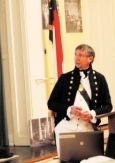War of 1812 focus of talk at museum
By Josh Ellerbrock
Published in News on December 12, 2012 1:46 PM

Josh Ellerbrock
James Greathouse, a historian out of Fayetteville, talks about North Carolina's role in the War of 1812 to a gathering at the Wayne County Historical Museum Tuesday night.
"What's the first thing you think of when it comes to the War of 1812 and North Carolina?" asked James Greathouse, a historian out of Fayetteville, to a gathering at the Wayne County Historical Museum Tuesday night. Those assembled remained quiet.
"You think of nothing," Greathouse answered for them. Which, he added was indeed the correct answer if they ignored the many North Carolinians who made names for themselves during the war.
Greathouse, the historic properties coordinator for the city of Fayetteville, was invited to the Wayne County Historical Museum to lecture on North Carolina's involvement in the War of 1812 by Chris Lawson, the assistant director to the museum. Greathouse currently serves as a member of the North Carolina 1812 Bicentennial Committee, which commemorates the 200th anniversary of America's second war.
Most of the battles of the War of 1812, the second war between Americans and the British in early American history, took place far from North Carolina's soil. Yet, a few famous figures from the time period came from North Carolina, making commemoration of "America's second war of independence" and North Carolina's exploits in that war a worthy endeavor, Greathouse said.
First among those North Carolinians is Dolly Madison, wife to President James Madison, who led the country at the time. History shows Mrs. Madison as the daring rescuer of a more-than-6-foot-tall portrait of George Washington during the burning of Washington, D.C., by the British. The time period knew Mrs. Madison, however, as a successful socialite who threw "squeezes," or highly attended balls, for the American political elite.
Other big names from North Carolina include Otway Burns, a merchant turned highly successful privateer, and Johnston Blakeley, a naval commander who went bow-to-bow with ships in the English Channel.
As for more common soldiers, North Carolina did send some soldiers, including militiamen, infantrymen, dragoons, riflemen and artillery to fight, yet few ever ended up lighting any powder in combat. North Carolinians also helped patrol America's coastline by building three gunboats -- small, light and cheap vessels with little firepower compared to British frigates.
On a more local level, Wayne County sent more than 200 militiamen in their own organized companies. Most of those men ended up languishing in forts instead of taking to the front lines. Even so, Greathouse said, these men deserve commemoration.
"If you take away anything from the Wayne County militia, they may not have fought the British army, but they did what they were told to do to the best of their ability," Greathouse said. "They did their duty."
For more information on North Carolina's involvement in the War of 1812, visit the North Carolina 1812 Bicentennial Committee's website at http://nc1812.ncdcr.gov.
